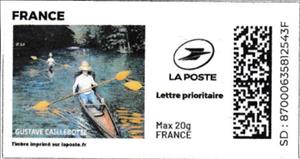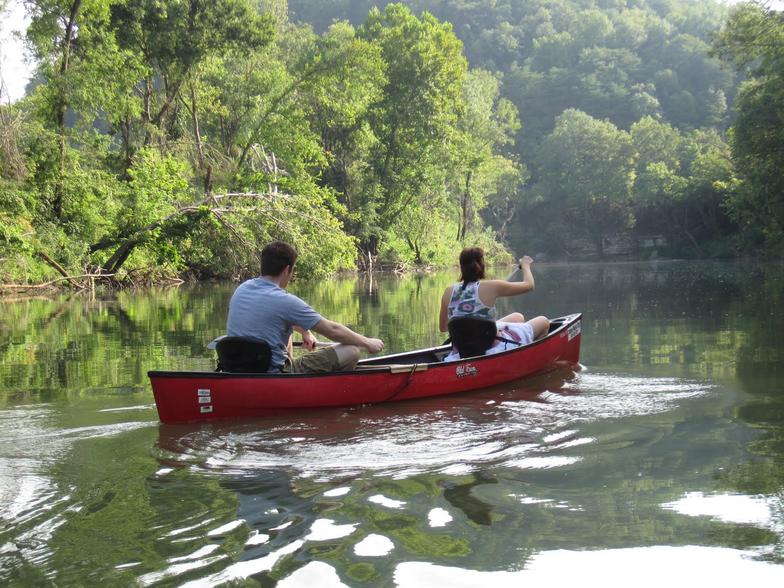Stamp: Gustave Caillebotte. Canoe on the Yerres. Redesign (France 2022)
Gustave Caillebotte. Canoe on the Yerres. Redesign (France 2022)
01 January (France ) within release MonTimbrEnLigne. Art goes into circulation Stamp Gustave Caillebotte. Canoe on the Yerres. Redesign face value Prioritaire No Face Value
| Stamp Gustave Caillebotte. Canoe on the Yerres. Redesign in catalogues | |
|---|---|
| Colnect codes: | Col: FR-TIM 2022-115 |
Stamp is square format.
Also in the issue MonTimbrEnLigne. Art:
- Stamp - Gustave Caillebotte. Canoe on the Yerres. Redesign face value Prioritaire;
- Stamp - Claude Monet. Water Lily Pond. Redesign face value Lettre;
- Stamp - Vincent Van Gogh. Wheat field with Cypresses. Redesign face value Lettre;
- Stamp - Paul Cezanne. Gulf of Marseille. Redesign face value International20;
- Stamp - Claude Monet. River Sail Boat and Bridge at Argenteuil face value Lettre;
- Stamp - Vincent Van Gogh. Wheat field with Cypresses. Redesign face value Lettre;
- Stamp - Auguste Renoir. Pont Neuf. Redesign, without laposte logo face value Prioritaire;
- Stamp - Gustave Caillebotte. Canoe on the Yerres. Redesign no logo face value Lettre;
Stamp Gustave Caillebotte. Canoe on the Yerres. Redesign it reflects the thematic directions:
Art is a diverse range of human activities in creating visual, auditory or performing artifacts (artworks), expressing the author's imaginative or technical skill, intended to be appreciated for their beauty or emotional power. In their most general form these activities include the production of works of art, the criticism of art, the study of the history of art, and the aesthetic dissemination of art. The oldest documented forms of art are visual arts, which include creation of images or objects in fields including painting, sculpture, printmaking, photography, and other visual media. Architecture is often included as one of the visual arts; however, like the decorative arts, or advertising, it involves the creation of objects where the practical considerations of use are essential—in a way that they usually are not in a painting, for example. Music, theatre, film, dance, and other performing arts, as well as literature and other media such as interactive media, are included in a broader definition of art or the arts. Until the 17th century, art referred to any skill or mastery and was not differentiated from crafts or sciences. In modern usage after the 17th century, where aesthetic considerations are paramount, the fine arts are separated and distinguished from acquired skills in general, such as the decorative or applied arts.
Canoeing is an activity which involves paddling a canoe with a single-bladed paddle. Common meanings of the term are limited to when the canoeing is the central purpose of the activity. Broader meanings include when it is combined with other activities such as canoe camping, or where canoeing is merely a transportation method used to accomplish other activities. Most present-day canoeing is done as or as a part of a sport or recreational activity. In some parts of Europe canoeing refers to both canoeing and kayaking, with a canoe being called an open canoe.
Painting is the practice of applying paint, pigment, color or other medium to a solid surface (support base). The medium is commonly applied to the base with a brush, but other implements, such as knives, sponges, and airbrushes, can be used. Painting is a mode of creative expression, and the forms are numerous. Drawing, gesture (as in gestural painting), composition, narration (as in narrative art), or abstraction (as in abstract art), among other aesthetic modes, may serve to manifest the expressive and conceptual intention of the practitioner. Paintings can be naturalistic and representational (as in a still life or landscape painting), photographic, abstract, narrative, symbolistic (as in Symbolist art), emotive (as in Expressionism), or political in nature (as in Artivism). A portion of the history of painting in both Eastern and Western art is dominated by spiritual motifs and ideas. Examples of this kind of painting range from artwork depicting mythological figures on pottery, to Biblical scenes rendered on the interior walls and ceiling of the Sistine Chapel, to scenes from the life of Buddha or other images of Eastern religious origin. In art, the term painting describes both the act and the result of the action. The support for paintings includes such surfaces as walls, paper, canvas, wood, glass, lacquer, clay, leaf, copper and concrete, and the painting may incorporate multiple other materials including sand, clay, paper, plaster, gold leaf, as well as objects. The term painting is also used outside of art as a common trade among craftsmen and builders.
A river is a natural freshwater stream that flows on land or inside caves towards another body of water at a lower elevation, such as an ocean, lake, or another river. A river may run dry before reaching the end of its course if it runs out of water, or only flow during certain seasons. Rivers are regulated by the water cycle, the processes by which water moves around the Earth. Water first enters rivers through precipitation, whether from rainfall, the runoff of water down a slope, the melting of glaciers or snow, or seepage from aquifers beneath the surface of the Earth.




